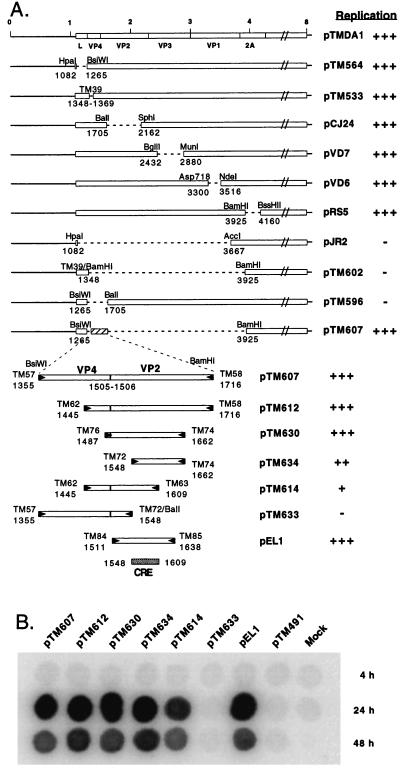Figure 1.
Localization of the replication element. (A) The various replicons derived from pTMDA1 are represented. Plasmids pTM564, pTM533, pCJ24, pVD7, pVD6, and pRS5 were described earlier (18). pJR2 was constructed by deleting a restriction fragment comprised between a HpaI site introduced by site-directed mutagenesis at nucleotide 1,082 and an AccI site at nucleotide 3,667. pTM602 was derived from pTM533 by the deletion of a BamHI restriction fragment and filling-in the restriction sites to restore the reading frame. pTM596 results from a BsiWI-BalI deletion of pTMDA1. pTM607 was obtained by replacing a BsiWI-BamHI restriction fragment of pTMDA1, extending from region L to region 2A, by a 362-bp PCR fragment (enlarged) containing the VP4-VP2 boundary. BamHI or BsiWI restriction sites were incorporated into the primers to facilitate the cloning of the PCR fragment between the corresponding sites of pTMDA1. The other constructs were obtained by cloning various PCR-amplified subfragments of this region between the same sites. pTM633 was derived from pTM607 by the deletion of fragment starting at a BalI site introduced at nucleotide 1,548 by site-directed mutagenesis with oligonucleotide TM72, and the BalI site contained in the genome at nucleotide 1,708. pTM634 has a deletion from the artificial BalI site introduced at nucleotide 1,548 and the BsiWI site filled-in with Klenow enzyme. Dotted lines indicate the deletions. RNAs transcribed in vitro from the various constructs were transfected into BHK-21 cells. Replication of the genomes was followed by dot blot hybridization. (+++, ++, +, −) indicate the replication levels from wild type (+++) to absence of detection (−). The dotted box identifies the 62-nt region deduced to contain the minimal replication element (CRE). (B) Dot blot hybridization of RNA extracted 4 hours, 24 hours, and 48 hours after transfection. RNA replication levels peaked ≈24 hours after transfection. The subsequent decrease in RNA levels probably reflects cell death caused by the accumulation of viral products. pTM491 was used as a negative control. It is a replication-deficient construct carrying an out-of-frame deletion extending from the 2C to the 3C region.

